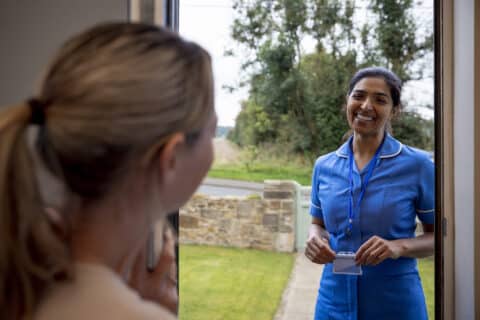Healthcare employers are transforming the way they provide safety for home-visiting staff, writes Darren Chalmers-Stevens of CriticalArc, makers of SafeZone.
Healthcare professionals working remotely, including those carrying out home visits, travelling between locations, and working in community clinics, are at increased risk of harm compared with their colleagues based in large hospitals.
Up until recently employers had limited opportunities to mitigate these risks. But today new strategies are being adopted that are proving highly effective and faced with increased difficulties recruiting and retaining skilled people, Trusts are finding ways to raise standards of personal safety for all their people working remotely, not just those deemed to be at particular risk.

Ability to Perform
Increasingly, healthcare providers understand that how safe employees feel can have a direct impact on their productivity, morale, and ability to perform. Indeed, perceptions of safety are almost as important as the reality; when continual anxiety affects a few individuals it can be damaging enough, but if not addressed, that harmful stress can spread and impact whole teams. This can lead to a downward spiral, with staff who are less confident becoming less effective at de-escalation, less able to control their interactions with others and, consequently, even more vulnerable.
For example, if a community nurse has to travel through an area that feels unsafe to them, they will be disincentivised; if they have to make that same journey regularly, if they start to dread it, there’s a chance they’ll start looking for alternative work – and the less safe they feel, the more they’ll be motivated to switch.
The reality for many healthcare workers, of course, is that verbal and physical aggression – or the threat of it – are regular occurrences. This can be hard enough to deal with in hospital settings, where employees have the support of colleagues, and where security staff may be on hand to help, but for those working in isolation it is much more challenging.
Rising Anxiety – a Growth Trend to Worry About
Staff anxiety is becoming more of a problem for employers, and for several reasons healthcare workers are more tuned into personal safety than in the past.
COVID, and pressures felt from the sharp increase on cost of living, has undoubtedly had an unsettling effect. As well as disrupting everyday life and increasing stress levels in wider society, it made people more aware of their own vulnerabilities. Adding to a general sense of heightened risk, high profile cases of violent crime have led to heartfelt campaigns focusing public awareness, for example highlighting the issue of gender-based violence against women, and the endemic problem of sexual harassment.
With continual media reporting of serious crimes such as gun violence and other violent related stories, feeds into a growing sense of ‘lawlessness’.
Against this backdrop, employers in the sector are facing staff shortages that make it more difficult to recruit people with the right experience and qualifications. They are forced to allocate increased budgets to hiring bank and agency staff, they are saddled with higher recruitment costs, and they face the prospect of litigation or penalties from regulators if they fail in their duty of care to keep staff safe.

New technologies have become available that allow healthcare employers to address these problems, extending the reach of their security and safeguarding services to protect staff who are working remotely or travelling between locations.
Anyone who has used traditional safety solutions will know their limitations. Traditional duress, RTLS (real-time locating systems) and lone worker solutions can suffer from lack of geographic reach, limited functionality, and poor usability. Often, they are expensive to operate and maintain, and pricing structures can be a disincentive to widespread use.
In some cases, organisations have been forced to compromise and limit the number of users on their systems. Sometimes duty of care responsibility is pushed down to individual line managers who may be clinical specialists but do not have the expertise to choose which of their colleagues should be protected and which, because they are deemed to be at less risk, should not.
But as a result of recent innovations, such compromises are no longer necessary. Response teams can now receive and act upon emergency help requests from health and care practitioners wherever they are – in the community, visiting patients’ homes, travelling, walking to and from their cars – and on the screens in front of them monitoring teams can have all the instant information they need to trigger a rapid response, if required.
This is the kind of capability that was just not available only a few years back. Equipped with it, responders can now pinpoint exactly where a health worker asking for help is; they can see pre-registered information about any additional vulnerabilities that person has (medical conditions, problematic relationships, protected attributes, other factors that may put them at particular risk); they can coordinate attendance by the nearest responders.
Continual 24/7 Coverage Made Affordable
The security monitoring teams might be based in dedicated control rooms run by Trusts or run by third-party service providers; some organisations are using a combination of the two, running their own security monitoring operations some of the time, and handing over to remote service providers out-of-hours or when things become too busy.
Whichever model is being used, the result is continual 24/7 coverage, and improved protection for remote working staff, that’s both affordable and flexible. So, healthcare staff on home visits may be ‘out of sight’ compared to their hospital-based colleagues, but they should never be ‘out of mind’.
